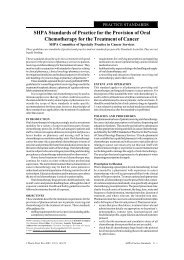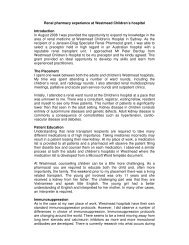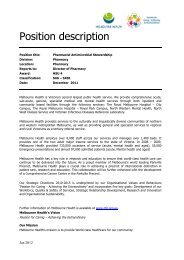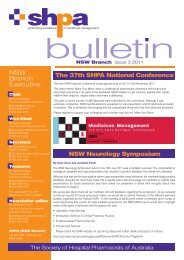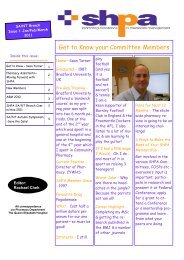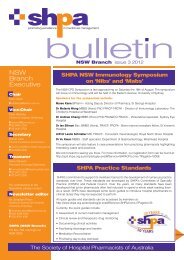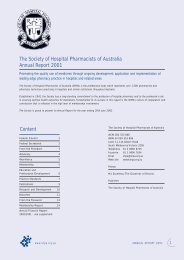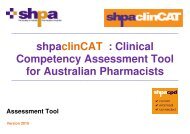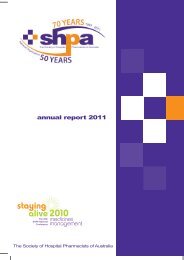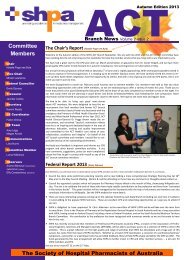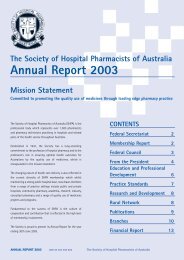references and background material - The Society of Hospital ...
references and background material - The Society of Hospital ...
references and background material - The Society of Hospital ...
You also want an ePaper? Increase the reach of your titles
YUMPU automatically turns print PDFs into web optimized ePapers that Google loves.
10. Australian Commission on Safety <strong>and</strong> Quality in Health Care. World Health Organization’s High 5s Medication<br />
Reconciliation Project. Sydney: ACSQHC; 2011. Available from <br />
11. Australian Commission on Safety <strong>and</strong> Quality in Health Care (ACSQHC). <strong>Hospital</strong> Accreditation workbook. Sydney:<br />
ACSQHC, 2012.<br />
12. Duguid M. <strong>The</strong> importance <strong>of</strong> medication reconciliation for patients <strong>and</strong> practitioners. Aust Prescr 2012; 35: 15-9.<br />
13. <strong>The</strong> <strong>Society</strong> <strong>of</strong> <strong>Hospital</strong> Pharmacists <strong>of</strong> Australia. SHPA St<strong>and</strong>ards <strong>of</strong> practice for the provision <strong>of</strong> medication<br />
reconciliation. J Pharm Pract Res 2007; 37: 231-3.<br />
14. Australian Commission on Safety <strong>and</strong> Quality in Health Care. Medication Reconciliation. Sydney: ACSQHC; 2011.<br />
Available from <br />
15. McLeod SE, Lum E, Mitchell C. Value <strong>of</strong> medication reconciliation in reducing medication errors on admission to hospital.<br />
J Pharm Pract Res 2008; 38: 196-9.<br />
16. Australian Commission on Safety <strong>and</strong> Quality in Health Care. Match Up Medicines. A Guide to Medication Reconciliation.<br />
Commonwealth <strong>of</strong> Australia; 2010. Available from <br />
17. Australian Commission on Safety <strong>and</strong> Quality in Health Care (ACSQHC). Safety <strong>and</strong> Quality Improvement Guide St<strong>and</strong>ard<br />
4: Medication Safety (October 2012). Sydney. ACSQHC, 2012.<br />
18. Roughead EE, Semple SJ. Review. Medication safety in acute care in Australia: where are we now Part 1: a review <strong>of</strong><br />
the extent <strong>and</strong> causes <strong>of</strong> medication problems 2002–2008. Aust New Zeal<strong>and</strong> Health Policy 2009; 6: 18. Published online<br />
2009 August 11. Doi: 10.1186/1743-8462-6-18. Available from .<br />
19. Garling P. Final report <strong>of</strong> the Special Commission <strong>of</strong> Inquiry: Acute Care in NSW Public <strong>Hospital</strong>s. Volume 1. Sydney: NSW<br />
Government; 2008. Available from: . Accessed November<br />
2011.<br />
20. NSW TAG <strong>and</strong> the Clinical Excellence Commission. Indicators for Quality use <strong>of</strong> Medicines in Australian <strong>Hospital</strong>s. NSW<br />
<strong>The</strong>rapeutic Advisory Group, Sydney 2007. Available from <br />
21. Stowasser DA, Collins DM, Stowasser M. A r<strong>and</strong>omised controlled trial <strong>of</strong> medication liaison services-patient outcomes. J<br />
Pharm Pract Res 2002; 32: 133-40.<br />
22. Carter MK, Allin DM, Scott LA, Grauer D. Pharmacist-acquired medication histories in a university hospital emergency<br />
department. Am J Health Syst Pharm 2006; 63: 2500-3.<br />
23. Stowasser DA, Allinson YM, O’Leary KM. Underst<strong>and</strong>ing the Medicines Management Pathway. J Pharm Pract Res 2004;<br />
34: 293-6.<br />
24. Reeder TA, Mutnick A. Pharmacist-versus physician-obtained medication histories. Am J Health Syst Pharm 1008; 65:<br />
857-60.<br />
25. Tan VC, Knowles SR, Cornish PL, Fine N, Marchesano R, Etchells EE. Frequency, type <strong>and</strong> clinical importance <strong>of</strong><br />
medication history errors at admission to hospital: a systematic review. CMAJ 2005; 173: 510-5.<br />
26. De Winter S, Spreit I, Indevuyst C, Vanbrabant P, Desruelles D, Sabbe M et al. Pharmacist-versus physician acquired<br />
medication history: a prospective study at the emergency department. Qual Saf Health Care 2010; 10: 371-5.<br />
27. Taylor SE, Thompson B, Garrett K, et al. Comprehensive evaluation <strong>of</strong> the role <strong>of</strong> a clinical pharmacist in the emergency<br />
department. Quality Improvement Funding Final Report. Melbourne: Department <strong>of</strong> Human Services; 2003.<br />
28. Stuchberry P, Kong DCM, DeSantis GN, Lo SK. Determining clinical pharmacy workload by patient disease classification in<br />
medical <strong>and</strong> surgical patients. J Pharm Pract Res 2008; 38: 126-31.<br />
29. deClifford J, Blewitt P, Lam SS, Leung BK. How do clinical pharmacists spend their working day A time-<strong>and</strong>-motion study.<br />
J Pharm Pract Res 2012; 42: 134-9.<br />
30. Nester TM, Hale LS. Effectiveness <strong>of</strong> a pharmacist-acquired medication history in promoting patient safety. Am J Health<br />
Syst Pharm 2002; 59: 2221-5.<br />
31. Murphy EM, Oxencis CJ, Klauck JA, Meyer DA, Zimmerman JM. Medication reconciliation at an academic medical centre:<br />
implementation <strong>of</strong> a comprehensive program from admission to discharge. Am J Health Syst Pharm 2009; 66: 2126-31.<br />
32. Vira T, Colquhoun M, Etchells E. Reconcilable differences: correcting medication errors at hospital admission <strong>and</strong><br />
discharge. Qual Saf Health Care 2006; 15: 122-6. Doi: 10.1136/qshc.2005.015347.<br />
33. Wilson SG, Tsui M, Tong N, Wilson DI, Chapman CB. <strong>Hospital</strong> pharmacy service provision in Australia-1998. Am J Health<br />
Syst Pharm 2000; 57: 677-80.<br />
SHPA Medicines in focus BACKGROUND MATERIAL – Medication reconciliation – November 2012 7 <strong>of</strong> 8




